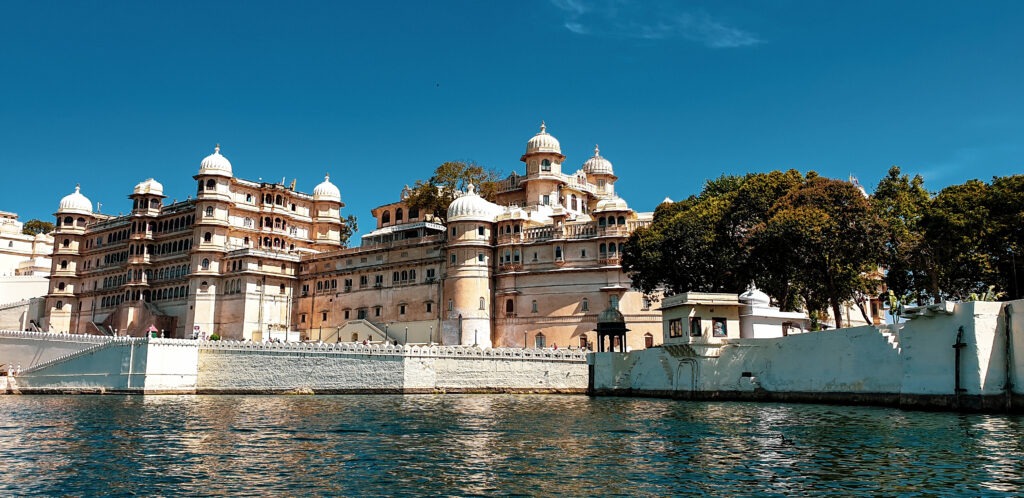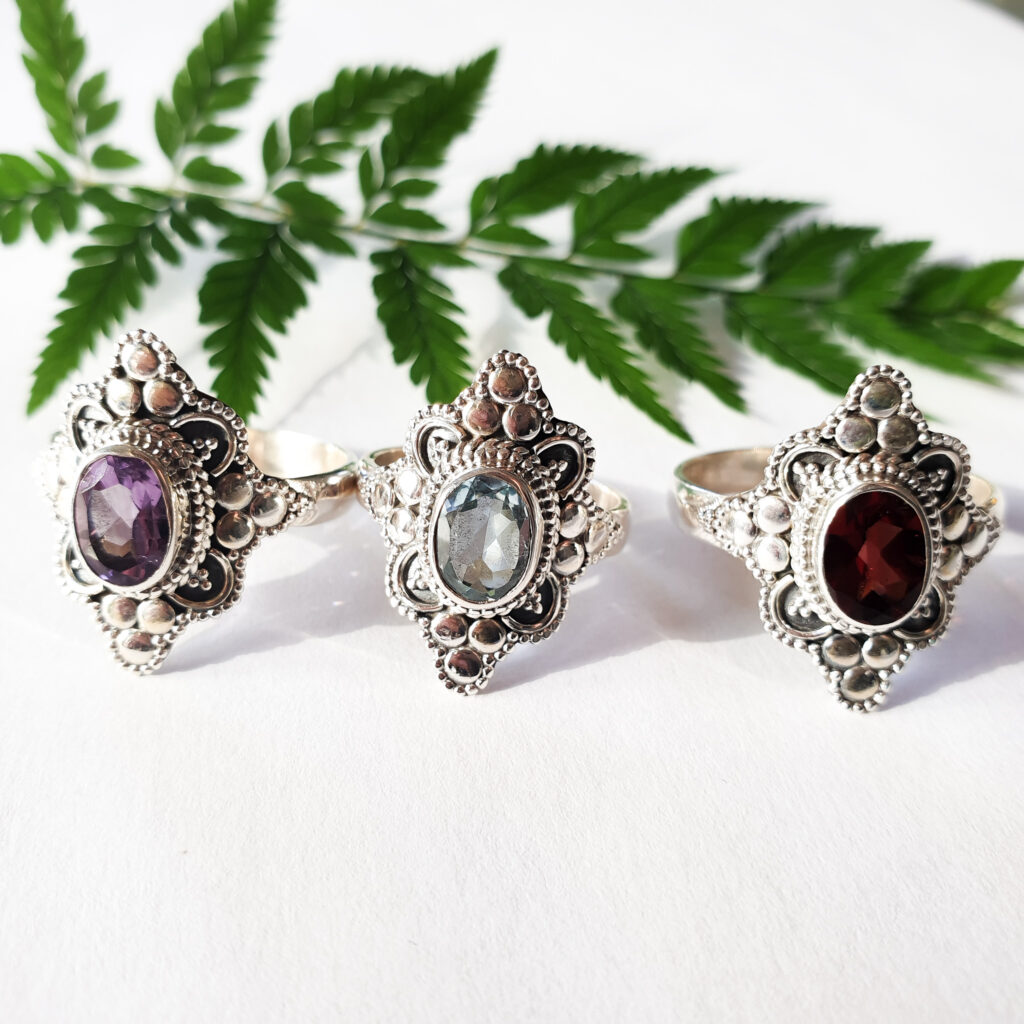Rajasthan, a northwestern state in India, is renowned for its rich history, stunning architecture, and vibrant culture. It’s a land of palaces and forts, each with its unique charm and historical significance. Discover the majestic palaces to visit or to stay at in Rajasthan. As a few palaces are museums or converted into hotels. In this article I dive deeper into the architecture and history of these magnificient palaces.
Table of Contents
City Palace in Udaipur
One of the most splendid and inspiring palaces in Udaipur is the City Palace, a stunning marvel of Rajasthani and Mughal architecture. The palace is a prime example of what rich cultural heritage India has to offer.
The construction of the City Palace began in 1559 and took over 400 years to complete. The palace is a fusion of Rajasthani and Mughal styles of architecture. It reflects the rich history of Udaipur. The palace complex consists of several courtyards, gardens, and buildings that are a feast for the eyes.

Interior design
One of the most striking features of the City Palace is its intricate artwork that decorate the walls and ceilings of the palace. The colourful murals and frescoes depict the tales of Rajput kings and their battles, along with the daily life of people from Udaipur. The exquisite glass mirrors used in the mirrors palace reflect light in a cascading manner. Adding grace and elegance to the palace.
You’ll come across several breathtaking structures such as the Jagdish Temple, Sheesh Mahal, and the Mor Chowk. The Jagdish Temple, dedicated to Lord Vishnu is a perfect example of Indo-Aryan architecture. The Sheesh Mahal, or the Palace of Mirrors, was used as a royal treasury and is decorated with thousands of tiny mirrors. The Mor Chowk or Peacock Courtyard is known for its striking peacock-shaped arches and frescoes.
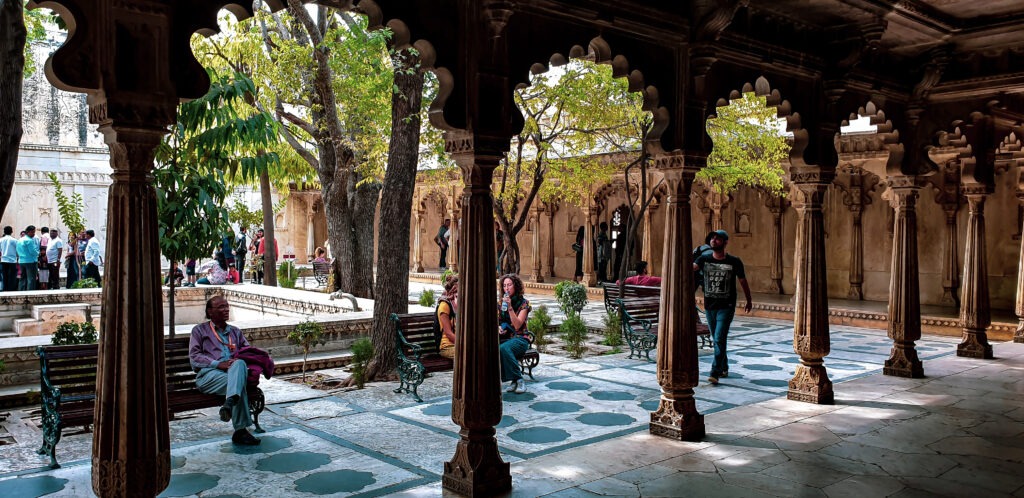
Palace Museum
Another important feature of the City Palace is the royal collection of weapons, clothes, and artifacts that are on display. The Palace Museum houses several rare and ancient artifacts, such as miniature paintings, Rajput weaponry, and royal attire. A visit to the museum is a must to get a glimpse of the rich history and culture of Rajasthan.
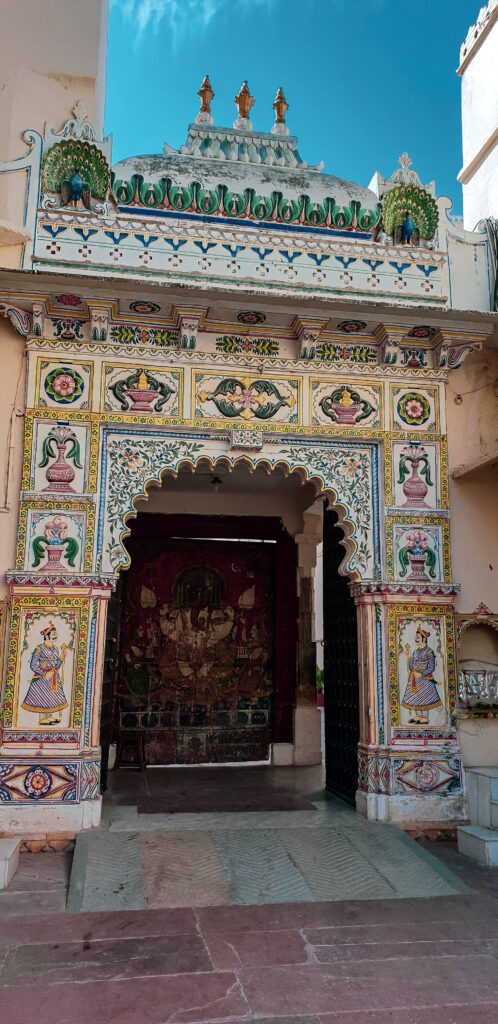
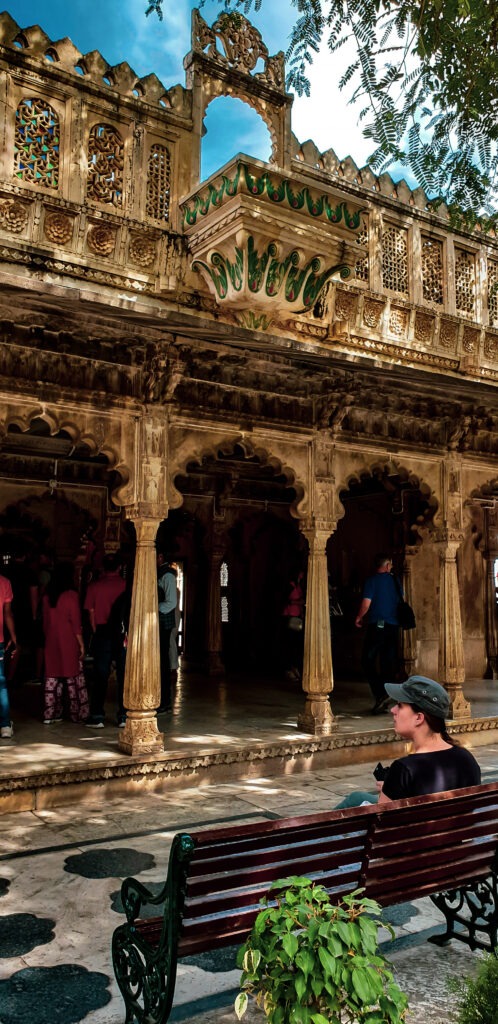
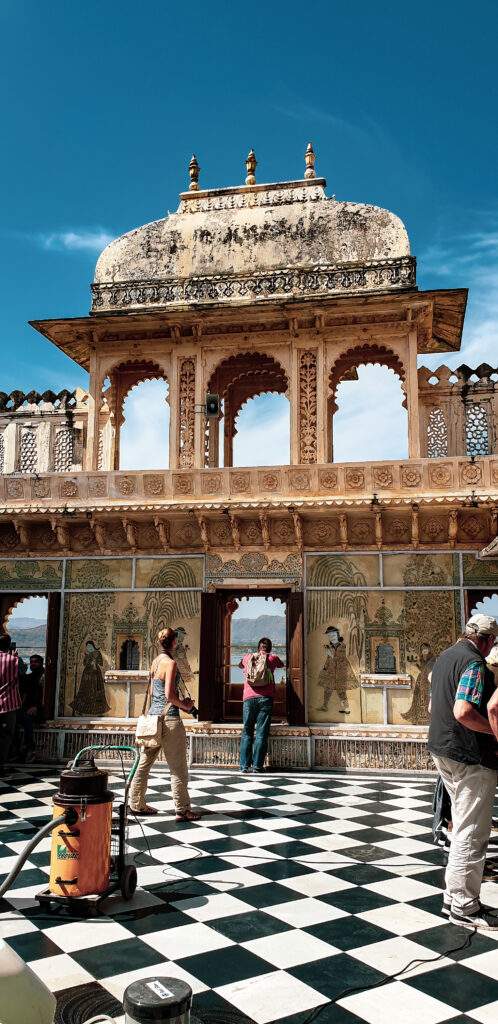
Umaid Bhawan Palace in Jodhpur
One of the majestic palaces to visit or to stay at in Rajasthanth is Umaid Bhawan Palace in Jodhpur. Here we are delving deeper into the architecture and history. You can’t miss visiting the Umaid Bhawan Palace in Jodhpur, India. This stunning palace is an embodiment of luxury, beauty and grandeur that will leave you impressed. Perched high on a hill, overlooking the blue city of Jodhpur, Umaid Bhawan Palace is more than just a palace. It’s a symbol of the royal heritage of Rajasthan. Let’s explore the history and architecture behind this magnificent palace.
History
The Umaid Bhawan Palace was built by Maharaja Umaid Singh. He is the grandfather of the present Maharaja Gaj Singh II. Construction began in 1929 during a time when Jodhpur was suffering from drought and famine. The palace was designed as a means of employment and to bring economic prosperity to the city. Over 3,000 artisans were employed to construct the palace and its beautiful gardens. It was built in three segments: the residence of the royal family, a museum showcasing the rich cultural heritage of Rajasthan, and a luxury hotel, The Taj Umaid Bhawan Palace.

Architecture
The Umaid Bhawan Palace is an architectural masterpiece. It is a fine blend of eastern and western architectural styles mixed with the beauty of Indian architecture. The palace is designed in Art Deco style, which was a popular style during the 1920s and 30s. The exterior of the palace is made of sandstone and resembles a large mansion rather than a palace. The interior of the palace comprises of 347 rooms, which include royal private chambers, a throne chamber, lounges, and dining halls. The palace is surrounded by 26 acres of lush gardens that are landscaped with a variety of exotic flora.
Museum
Part of the palace serves as a museum showcasing the lifestyle of the Maharajas of Jodhpur. It shows their collection of vintage cars, and a glimpse of the traditional and festive clothing of the people of Rajasthan. The museum serves as a repository of the bygone era of royalty and is open to visitors. You can check out the armoury of swords, shields and guns, and the vintage car collection including Rolls Royce, Cadillac, and Mercedes Benz.

Accommodation
The Umaid Bhawan Palace has been converted into a luxury hotel to offer guests an opportunity to experience the lavish lifestyle of the royals. The hotel has 64 guest rooms, including six royal suites in the palace, and 26 historical suites in the old palace wing. Every room offers a panoramic view of the blue city of Jodhpur, the Mehrangarh Fort, and the beautiful palace gardens.
To stay at Umaid Bhawan Palace
To visit the Umaid Bhawan Palace Museum
Hawa Mahal in Jaipur
The Hawa Mahal means the “palace of winds” or “palace of breezes,”. It was built in 1799 by Maharaja Sawai Pratap Singh. The palace was used as a place for the ladies of the royal family to observe the street festivities while maintaining their privacy. The unique design of the Hawa Mahal makes it an architectural wonder. With 953 small jharokhas or windows intricately carved out of pink sandstone, the palace was designed in the form of the crown of Lord Krishna. As you walk around in the palace, you can’t help but marvel at the skill and craftsmanship of the Rajputana artists who designed every little detail of this piece of art.
Harmony and balance
The Hawa Mahal has also been designed according to the principles of Vastu Shastra. An ancient science of architecture that stresses the importance of harmony and balance. The palace has five floors with a pyramidal structure of hopper-shaped roofs. Each floor has small chambers and windows arranged in a grid formation. The walls of the palace are decorated with beautiful paintings and murals that showcase the rich culture and traditions of Rajasthan.
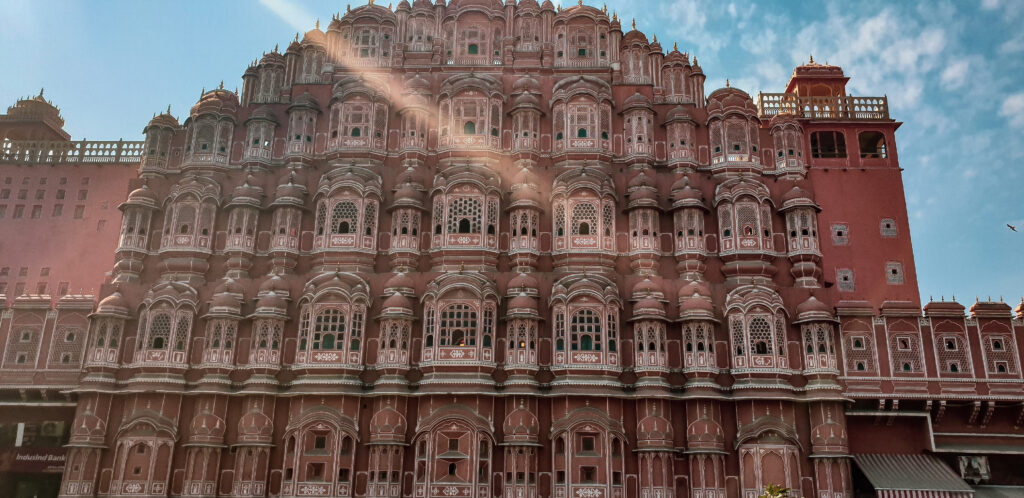
Best time to visit
A visit to the Hawa Mahal is a journey back in time. As you walk through the palace, you can’t help but feel the rich history of the land seeping in. Every corner of this palace has a story to tell, and it’s up to you to unravel its mysteries. The palace also houses a museum that showcases various royal artefacts and gives you a glimpse of the magnificent lifestyle of the Rajputana royals.
The palace comes alive during the morning and evening hours when the sunrays caress the pink sandstone façade, highlighting its intricate carvings and architectural beauty. As you step out of the palace, you are greeted by the bustling streets of the Pink City of Jaipur, which are just as enchanting as the palace. A stroll through these streets gives you an insight into the colourful culture and traditions of Rajasthan and its people.
Amber Palace in Jaipur
The history of the Amber Palace dates back to the 16th century when it was commissioned by Raja Man Singh I as a tribute to Mughal Emperor Akbar. The construction started in 1592 and took over two centuries to complete, with several additions made by successive rulers. The Amber Palace is a unique fusion of Mughal and Rajput architectural styles, a combination of grandeur, luxury and simplicity. Its sandstone and marble façade is decorated with intricate carvings and beautiful paintings that tell the stories of the past.
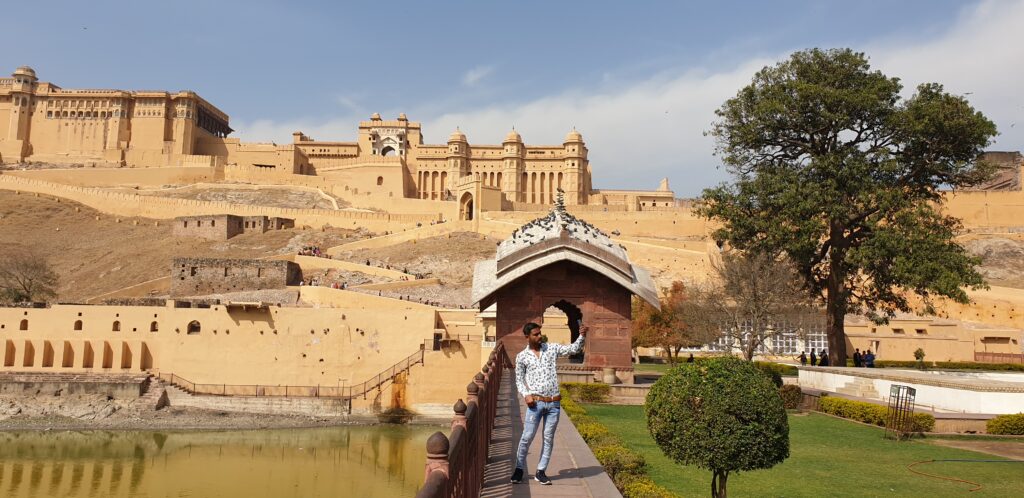
Interior design
As you enter the palace, it becomes evident that it is not just another palace, but a grand work of art. The intricate designs on the walls, the majestic gates, and the well-manicured gardens, all add to the beauty of the palace. The palace is divided into four sections, each with its own courtyard, garden, and pavilion. The palace also houses several temples. Including the famous Shila Devi Temple which is dedicated to the goddess Kali.
Mirror Palace
One of the most impressive features of the Amber Palace is the Sheesh Mahal or the Mirror Palace. This grand hall is decorated with thousands of tiny mirrors that reflect light in a beautiful and dazzling way, earning it the nickname “Palace of Mirrors”. The hall was built so that the queen could sleep under the stars without being exposed to the elements. In the daytime, the mirrors reflect light from the sun and at night, they reflect light from candles, creating a stunning and romantic ambiance.
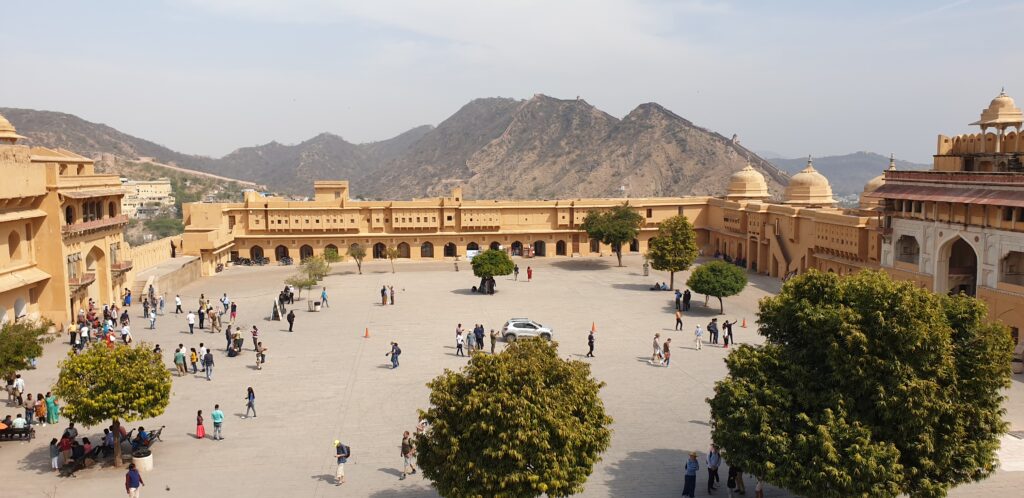
Jaigarh Fort
Another must-see attraction in the palace is the Jaigarh Fort, which is located adjacent to the Amber Palace. It was built in 1726 by Maharaja Sawai Jai Singh II as a military fort and palace for his army and has never been conquered. The fort has a museum that showcases various artefacts and weapons from the past, including cannons, swords, and guns.
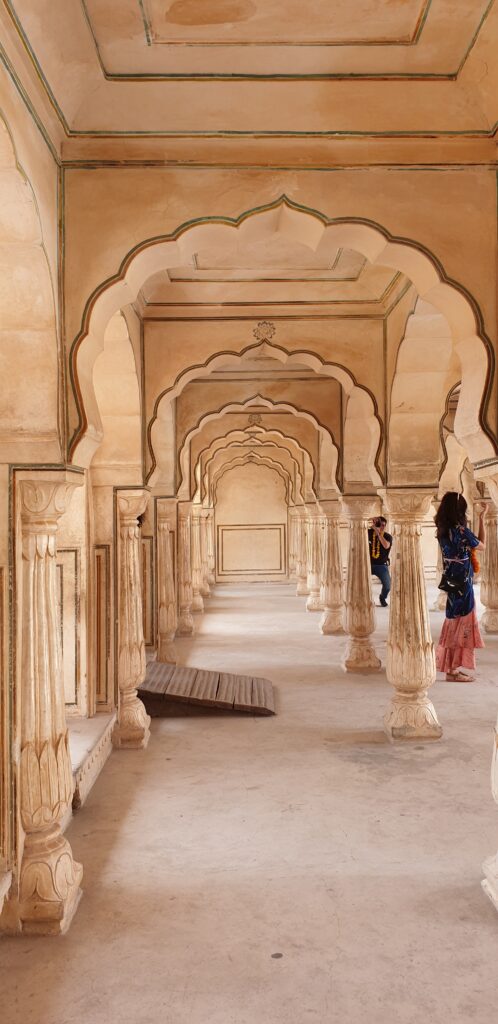
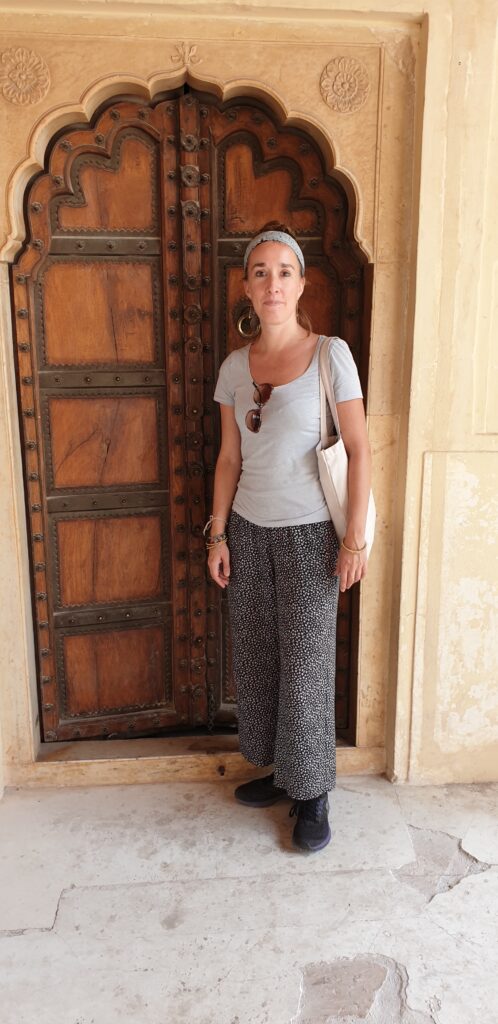
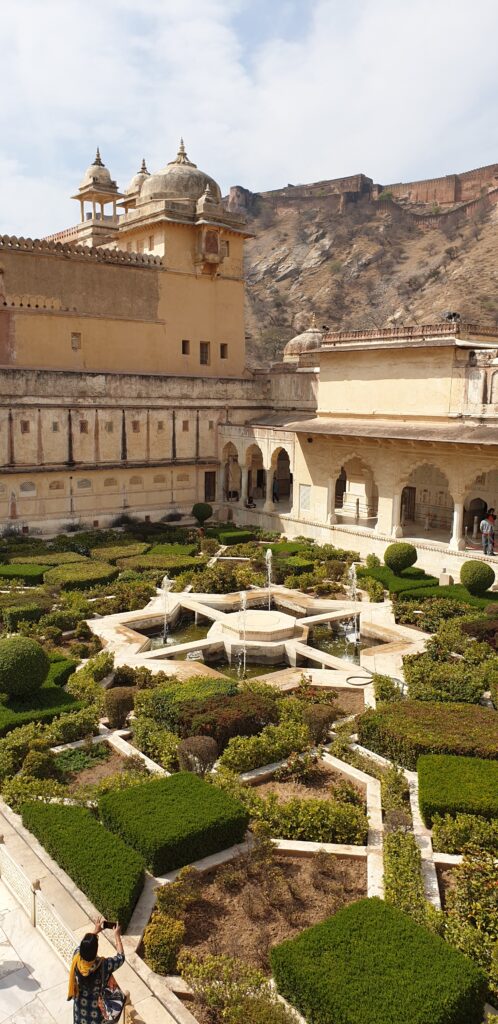
Mehrangarh Fort in Jodhpur
Another majestic palaces to visit is Mehrangarh Fort. It has a long and fascinating history. The construction of the fort dates back to 1460 and was built by Rao Jodha, the founder of Jodhpur. The fort was named Mehrangarh, which means ‘fort of the sun’, as it is located on a hill where the sun shines all day long. The fort also served as a protective barrier for the kingdom of Marwar, as it was a strategically important location.
The architectural design of the fort is of immense value. It is considered a masterpiece of Rajputana architecture. The forts’ walls are up to 36 meters high and 21 meters wide. The walls are made of red sandstone and have intricate carvings and panel paintings. The fort also has a variety of palaces. Including Moti Mahal, Phool Mahal, and Sheesh Mahal, which are decorated with colourful glass windows, mirror work, and paintings.

Hidden tunnels and passage ways
One of the most interesting architectural features of the Mehrangarh Fort is its network of tunnels and passages. It was designed to protect the fort from enemy attacks. In fact, the fort has never been conquered in a battle due to its impregnable defences. The tunnels and passages are also connected to various parts of the city, which made it easier for the royals to reach different parts of Jodhpur during times of war.
Apart from the architectural beauty of the fort, Mehrangarh Fort is also home to a massive collection of weapons, costumes, and artifacts. The collection provides insight into the royal lifestyle of the Rajput’s. The museum inside the fort has over 70 galleries. Each with a unique collection of items that reflect the culture and heritage of the region.
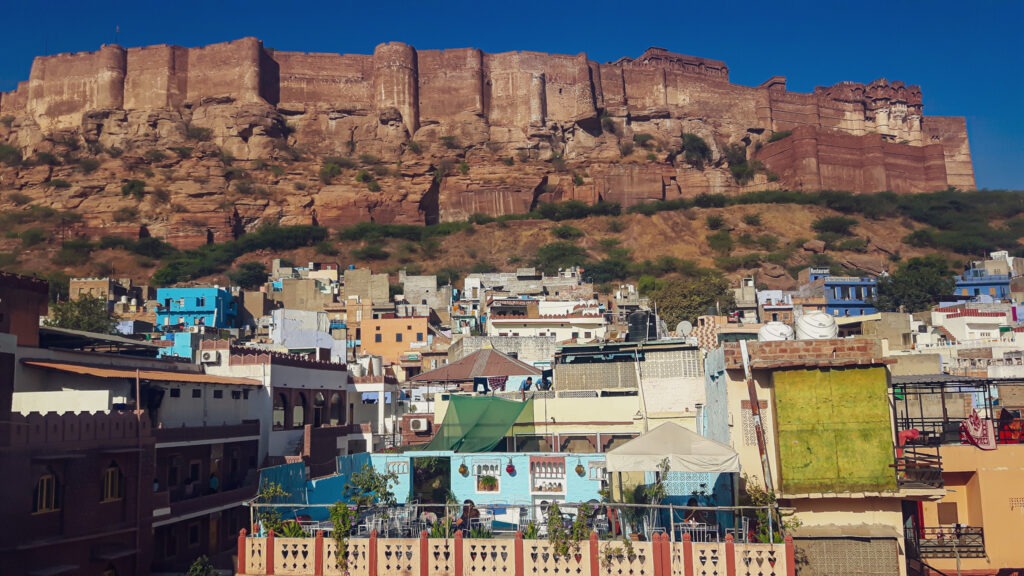
Junagarh Fort in Bikaner
History of Junagarh Fort
Junagarh Fort was commissioned by Raja Rai Singh, one of the most knowledgeable generals in the Mughal Empire. Raja Rai Singh supervised the construction of the fort between 1589 – 1594. He served five different Mughal emperors. The fort showcases the decorative aesthetics of the era. Later the fort served as a residence to several Bikaner kings, each of whom added a unique touch to the fort.
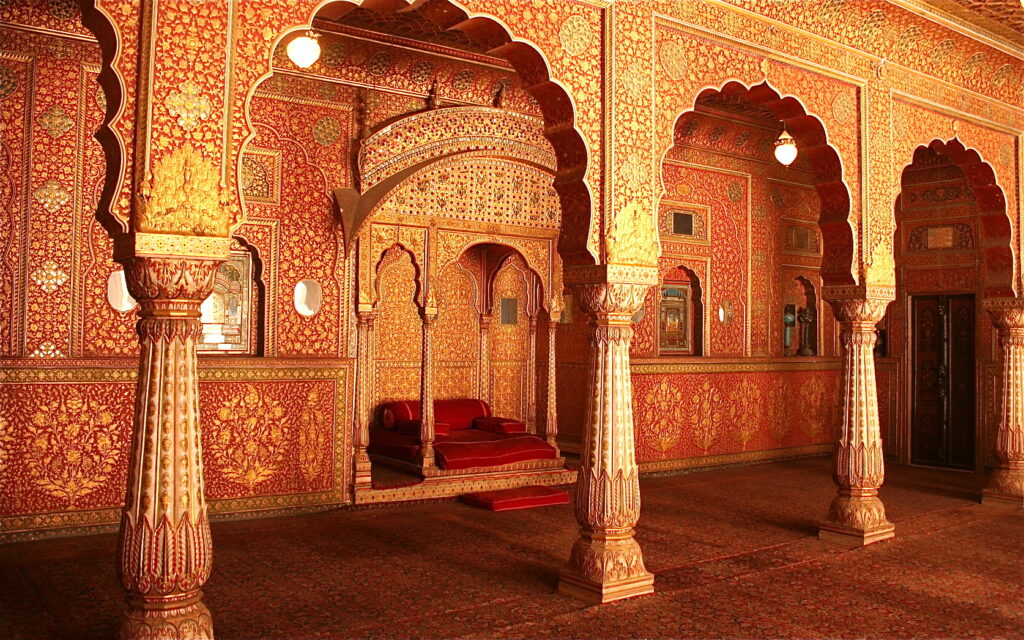
Architecture of Junagarh Fort
Junagarh Fort is a fascinating example of Rajputana architecture, including Hindu, Mughal and Western styles. The fort is fortified with high walls that are lined with long bastions and sturdy cannons. The complex is divided into several palaces, courtyards, temples, and gardens. The primary palace within the fort, Badal Mahal, is the centre of attention for visitors due to its beautifully painted interiors that showcase the Rajasthani art form of Phad painting. Other noteworthy buildings include Chandra Mahal, Phool Mahal, and Anup Mahal.
The learning centre of the Fort
The learning centre of the Junagarh Fort is called the Prachina Museum of cultural history. This interesting museum showcases the history, culture and lifestyle of the Bikaner Maharajas and the Rajput princes. It contains a fantastic collection of arms, costumes, woodworks, carpets, and jewellery, amongst other intriguing historical artifacts.
Lake Palace in Udaipur
The Taj Lake Palace was originally built in 1746 by Maharana Jagat Singh II. It wasn’t until the mid-19th century that it was converted into a luxurious, five-star hotel. The palace itself is situated on the picturesque Lake Pichola. It is surrounded by stunning gardens and fountains that make for the perfect photo opportunity.
When you step inside the palace, you’ll feel like you’ve been transported back in time to a golden era of Indian royalty. The architecture is simply breathtaking, featuring intricate carvings, ornate domes, and delicate mirror work that glitters in the light. Whether you choose to explore the palace’s many courtyards, wander through its opulent halls, or relax in its tranquil gardens, you’ll be surrounded by a sense of awe and wonder.
One of the most fascinating things about the Lake Palace is the way that its architecture and design reflects the cultural heritage of Udaipur and Rajasthan more broadly. The palace is built entirely from white marble, which was a significant departure from the traditional use of sandstone in the region. This was a deliberate choice by Maharana Jagat Singh II. He wanted to create a sense of grandeur and elegance that would set the palace apart from the other buildings in the city.
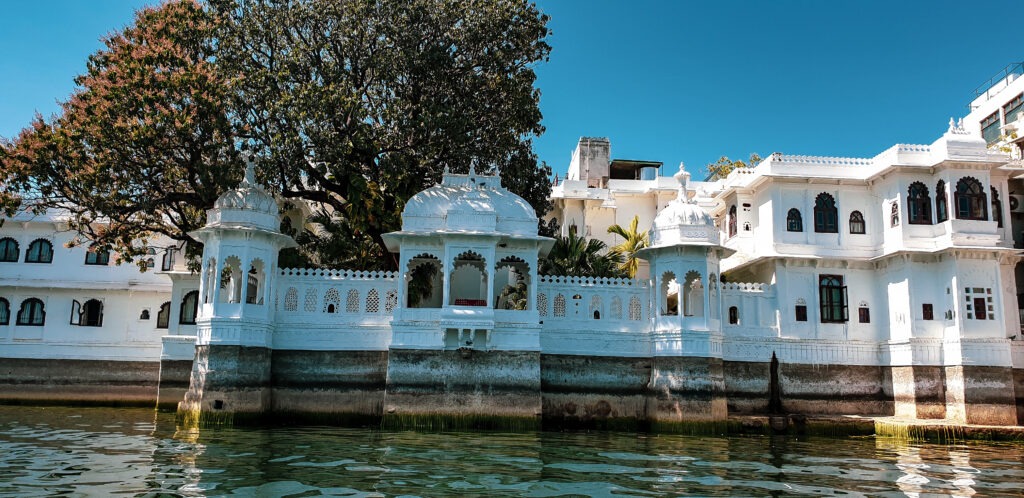
Another interesting aspect of the Lake Palace’s design is the way that it incorporates elements of both Hindu and Islamic architectural styles. From the intricate carvings on the palace’s pillars to the delicate jali screens that decorate its windows. The palace is a masterpiece of design that seamlessly blends together these different cultural influences.
To visit the Lake Palace
Regrettably, visiting the Lake Palace is not possible as it is only accessible for guests who have booked a room. If you desire to experience its charm, reserving accommodation on the premises is a necessity: Taj Lake Palace.
Rambagh Palace in Jaipur
The Rambagh Palace was built in 1835 as a residence for the queen’s favourite handmaiden. Eventually it became the residence of Maharaja Sawai Ram Singh II. He turned it to his principal residence. In 1925, it was converted into a luxury hotel, which is now managed by the Taj Group of Hotels. The palace covers an area of 47 acres and features 78 lavish rooms and suites with a rich blend of Indian and colonial décor.
Architecture
The architecture of the Rambagh Palace is an amalgamation of Rajput and Mughal styles, with intricate motifs, arches, domes, and pavilions. The palace is surrounded by lush gardens, courtyards, and fountains, and each room tells a story of the past. The walls are decorated with frescoes, oil paintings, and wall murals that depict stories of the glorious past of Rajasthan.
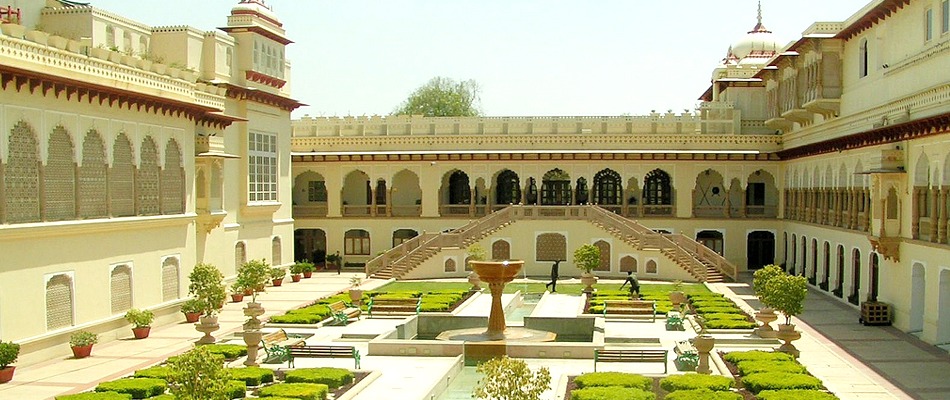
Fine dining
One of the highlights of the Rambagh Palace is the Suvarna Mahal restaurant, which offers a fine dining experience in the former banquet hall of the palace. The restaurant serves authentic Indian cuisine prepared with local spices and ingredients and features live classical music evenings. The Polo Bar is another favourite destination for visitors where you can enjoy an exquisite collection of wines and spirits in a colonial setting.
Apart from the amazing architecture the Rambagh Palace also offers a wide range of activities that cater to visitors of all ages. You can indulge in a luxurious spa treatment, take a dip in the pool, play a round of golf, or take a heritage walk around the palace gardens to explore the rich history of Rajasthan.
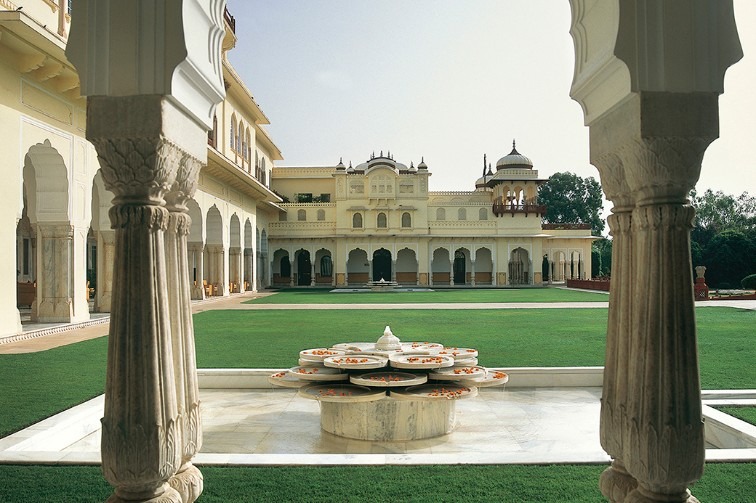
Lalgarh Palace in Bikaner
The Architecture of Lalgarh Palace
The architecture of Lalgarh Palace is a perfect blend of Rajputana, Mughal, and European styles. The palace is constructed using red sandstone, which makes it stand out from other palaces in Rajasthan. The intricate carvings on the palace walls and ceilings depict the tales of bravery of the former rulers of Bikaner. The inspiring latticework, jharoka, and jalli make the palace stand uniquely majestic. The palace has several courtyards, pavilions, and gardens.
History of Lalgarh Palace
The history of Lalgarh Palace dates back to 1902, when Maharaja Ganga Singh Ji commissioned the construction of the palace to commemorate his father Maharaja Lal Singh Ji. The palace was built to serve the purpose of a summer retreat for the king and his family. The palace has an incredible collection of paintings, photographs, ornaments, and weapons belonging to the rulers of Bikaner.
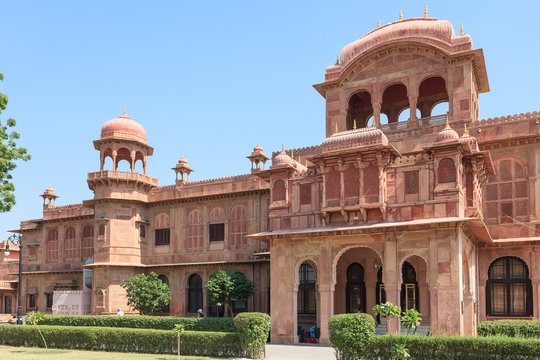
The Royal Experience at Lalgarh Palace
The Lalgarh Palace has been converted into a heritage hotel, which means that you can spend the night at this magnificent palace. Spending time at Lalgarh Palace can give you a taste of the royal lifestyle. The palace has several suites, which have been decorated with antique furniture, Rajasthani paintings, and exquisite artwork. The hotel also offers several amenities like swimming pools, spa, and restaurants, which make your stay even more comfortable.
Chittorgarh Fort
Unesco World Heritage
Chittorgarh Fort, also known as Chittor Fort, is a UNESCO World Heritage Site. The fort is located on the banks of the Berach river in Chittorgarh, Rajasthan. Built on a hill that rises above the surrounding plain, this fort has played a significant role in Indian history and is a famous tourist attraction today. The massive fort is spread across 700 acres and is surrounded by a 13 km long wall with seven monumental gates, or ‘pols‘. The fort has been attacked and conquered several times in history, which reflects the valour and bravery of the Rajput rulers.
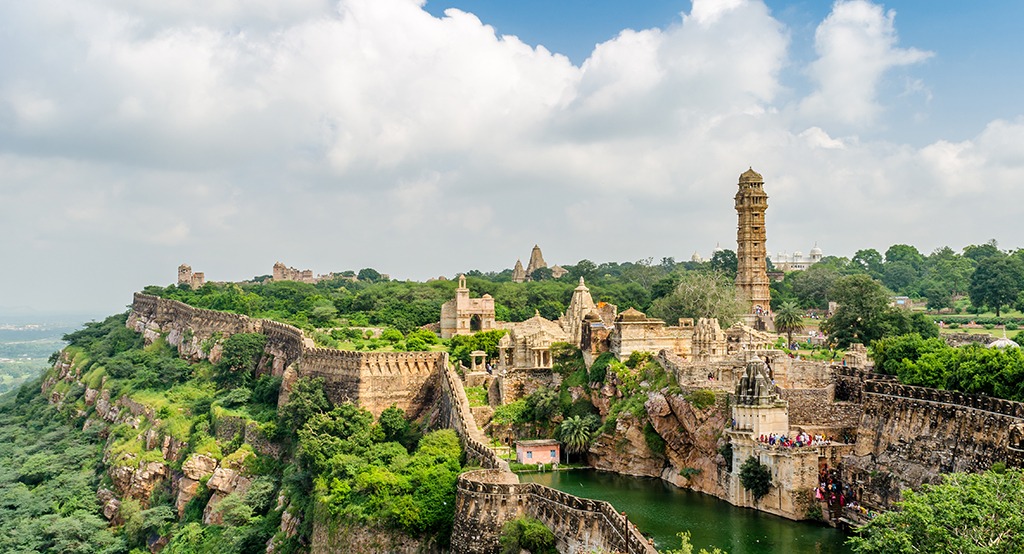
Architecture
The architecture of the Chittorgarh Fort is an excellent example of the Rajasthani style of building. The fort has many palaces, temples, and towers that stand strong and majestic even after centuries of wear and tear. Visitors can explore the Rana Kumbha Palace, the largest palace of the fort, which has an underground temple and a beautiful view of the surrounding landscape. The Kalika Mata Temple, dedicated to the Hindu Goddess, is another significant temple located inside the fort. The fort’s sheer magnitude and intriguing history can make one feel transported back in time.
One of the most iconic buildings inside the Chittorgarh fort is the Vijay Stambh or Tower of Victory. It is a 37mtr high structure visible from almost any point inside the fort. The tower was built by King Rana Kumbha to commemorate his victory over the Sultan of Gujarat in the 15th century. Visitors can climb to the top of the tower and enjoy a panoramic view of the surrounding region. Another marvel of engineering inside the fort is the Kirti Stambh. It’s another tower built in the 12th century to commemorate Jain teachings.
Cultural heritage
The Chittorgarh Fort has a rich history that has shaped India’s cultural heritage. The legendary tales of valour and bravery of the Rajput rulers that unfolded at this fort are known throughout the country. The fort has seen several sieges throughout history. The most notable one being the siege of Alauddin Khilji in 1303 when hundreds of Rajput warriors lost their lives. Another famous story is that of Rani Padmini, who immolated herself along with other women to escape the clutches of Alauddin Khilji and safeguard her honour.
Neemrana Fort Palace
The Neemrana Fort Palace is built on a prominent position on a plateau. The fort is offering a breathtaking view of the surrounding Aravalli Hills. The six-acre palace complex features a maze of beautifully maintained gardens, courtyards, and terraces that lead you to hidden corners, historical ruins, and mesmerizing views. Each section of the palace holds a unique story to tell. When you explore the palace’s seven distinct wings, you can learn about each of the Indian dynasties, the artwork and decorative finishes that make them distinct.
Architecture
One of the most significant attractions of Neemrana Fort Palace is its unique architecture. The palace combines different architectural styles and features. It reflects the influence of diverse cultures and traditions. You can see elements of Mughal, Rajput, and British architecture blending seamlessly together. The palace’s structure is made up of nine connecting sections. Each one has distinct features like cupolas, turrets, balconies, and courtyards that showcase different styles and eras.
Another fascinating aspect of the palace is its historical significance. The palace played a key role in India’s history. It used to be a vital centre of Indian politics and culture. Maharaja Prithvi Raj Chauhan III built the palace and ruled over it for many years. Later, it was taken over by the Marathas. After India gained independence, the palace was abandoned.
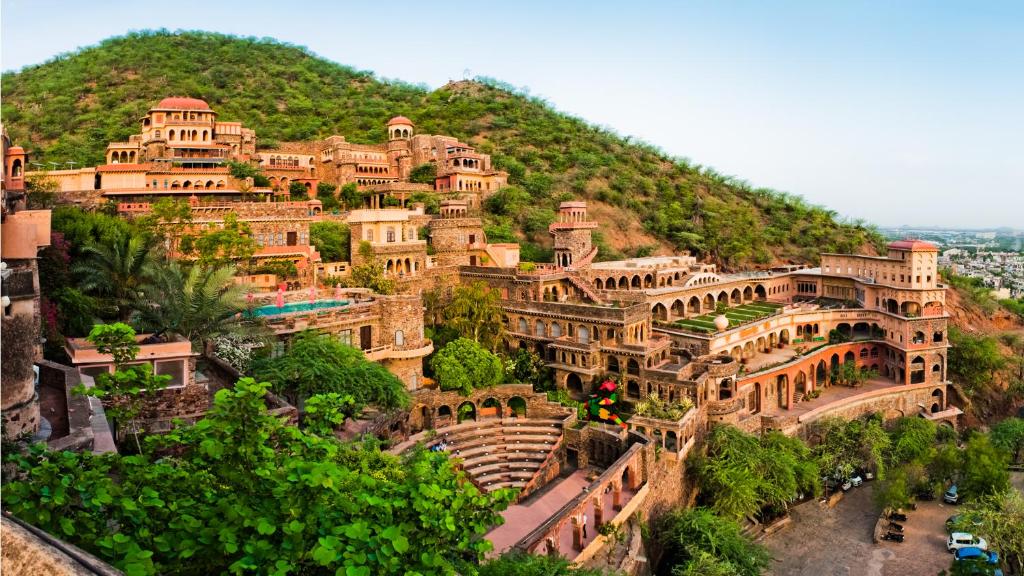
Heritage hotel
In 1986, the Neemrana Fort Palace was renovated and converted into a hotel. Today, the palace is a top-rated hotel, offering travellers a chance to experience the grandeur of Rajasthan’s ancient architecture and the warmth of its local culture. The hotel features 72 spacious rooms that have been restored to their original charm, with modern amenities added to ensure guests’ comfort.
When you stay at the Neemrana Fort Palace, you can indulge in a range of experiences that showcase the region’s culture and traditions. The hotel offers a range of activities, including royal dine experiences, zipline adventures, vintage car rides, traditional cooking classes, and spa services. The palace also provides an excellent base to explore the nearby towns of Alwar, Sariska, and Kesroli. Each with its own charm and history.
Monumental highlights to visit in India
Explore the rich tapestry of India with our comprehensive travel guide! Discover valuable tips, top destinations, and useful links to other India-related articles. Immerse yourself in the Indian culture and Hinduism with our beginner’s guide, which covers customs, etiquette, and key Hindu gods.
Seeking inspiration? Consider a visit to the enchanting City of Lakes, Udaipur, or indulge in a shopping spree in Jaipur. Marvel at the colonial architecture of Kochi in Kerala or explore historical temples, palaces, and ruins in Hampi. Let India’s wonders captivate you!
One of my latest articles is about The most fascinating festivals and celebrations in India. Or read more about sustainable travel India: How to get around in India as an eco-conscious tourist
